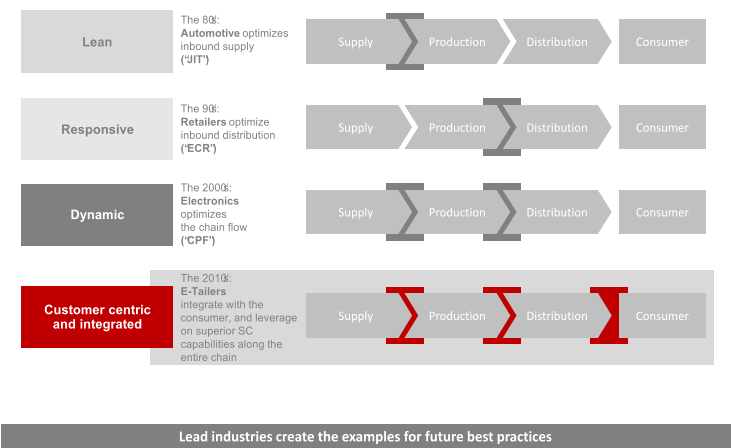

- Value Chain Excellence
- Company Business Performance
- Supply Chain Performance
- Supply Chain Strategy
- Integrated business management (S&OP)
- Digital Transformation
- Operational Improvement
- Transparency
- Complexity
- Agility
- Responsiveness
- Customer Needs
- Delivery Reliability
- SC Segmentation
- Inventory optimization
- Throughput Times
- Order Management
- Planning Excellence
- Cost management
- Logistics Cost
- Working Capital Optimization
- Supplier Optimization
- Transport Optimization
- Network Optimization
- Post Merger Integration
TODAY’S LEADING PRACTICES HAVE EVOLVED OVER DECADES;
INTEGRATING AND ACCELERATING THE FLOW OF GOODS TO THE CUSTOMER

Evolution of leading practices towards total integration
•
Every practice used in a supply chain is applied to solve a particular
problem. The nature of these solutions and the underlying problem
can be minor, or major. Sometimes these solutions are “game
changing”, leading to totally new ways to design, operate, and run
supply chains.
•
The first real movement towards a “chain” practice was the
invention of Just-in-Time concepts in the automotive industry. The
big challenge in the 80’s for this industry was the increasing level of
variety in final products - model range, but also feature variety. In
order to cope with the need to manage a complex inbound supply
of many components for the assembly timing of a particular end
product, a wide set of solutions was created to plan, produce,
buffer, and deliver the components. Just-in-Time was born, and was
at first internally perfectionized by Kanban Methods, which later on
spanned also towards the suppliers.
•
Retailers need products on the shelf - otherwise no revenue, and
even the risk of loosing a consumer to a competitor brand.
Transparency about purchases was required to collect the sold
units to trigger an automated replenishment order. Technically a
major challenge which was resolved, but the key challenge is the
political willingness of the retailer to share the sales data, and not
use their knowledge for price bargains.
•
Electronics had to face short product lifecycles, and high product
variety. The biggest cost of having intenvory turned from “cost of
capital” towards “cost of obsolescence”. Interestingly, this means a
much higher cost (and risk) than the interest rates which dominated
traditional inventory considerations. Therefore they combined the
concepts of ECR with JIT, added internal planning tools as well as
inventory management tools, enabling continuous product flows.
•
But now - E-Tailers control everything. They control the consumer in
its move to buy the product, and they control the chain which
delivers the product. In this, delivery does not mean the final
distribution, but the entire chain of making to the product. This gives
them immense power towards both ends, marking today’s leading
industry how to design, operate, run, continuously improve, and
also to innovate, a supply chain.
Welcome to the origin of today’s
leading supply chain practices!
•
Today, we live in a world in which
instant availability has become a
standard. We got used to fast
deliveries, to reliability regarding
promised delivery dates, and to a
low cost environment
•
But this has not always been the
case, but is the result of hard work of
many supply chain managers with
their teams to create new solutions,
and master all the challenges which
for long time seemed to prevent
their success.
•
Over time, it is interestingly possible
to link specific industries to major
breakthrough innovations regarding
leading practices in supply chains.















